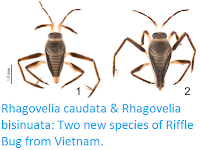The Assassin Bugs, Reduviidae, are carnivorous True Bugs, often noted for their ability as mimics, which enables them to strike rapidly at unsuspecting prey with their enlarged, stabbing proboscis. The Reduviinae is one of the largest subfamilies within the Reduviidae, currently comprising over 1070 species within 141 genera. However, it is probably paraphyletic (i.e. not all descendants of the most recent common ancestor of all members of the group are included in the group), despite the high level of similarity seen between members of the group, suggesting that it represents a sort of 'basic' Assassin Bug bodyplan from which more specialised groups have derived. The genus Acanthaspis currently contains 124 species, making it the second largest within the Reduviinae, and is particularly diverse in South Asia, making up 42 of the 98 species of Assassin Bug found in India.
In a paper published in the Pakistan Journal of Zoology on 9 February 2022, Syed Ishfaq Ali Shah of the Department of Entomology at the China Agricultural University, and the Entomology Section at the Central Cotton Research Institute, Azaz Ahmad of the Department of Entomology at the University of Agriculture, and Wanzhi Cai, also of the Department of Entomology at the China Agricultural University, describe a new species of Acanthaspis from Pakistan.
The new species is named Acanthaspis rafiqi, in honour of Muhammad Rafiq, the former head of the Entomology Section and Principal Scientific Officer at the Central Cotton Research Institute. The species is described from five specimens, a males and a female collected from the village of Arja in the Bagh district of Azad Jammu and Kashmir by Khifza Niaz and placed in the collection of the Pakistan Museum of Natural History, a male specimen collected from the Margalla Hills of Islamabad by Azaz Ahmad, and two further specimens found in the collection of the Pakistan Museum of Natural History, which were collected in the 1980s and bear the legend 'Arbro'; one of these was also collected in Islamabad, and the other has no collection data.
Male specimens of Acanthaspis rafiqi range from 16.00 to 16.20 mm in length, while females range from 16.16 to 16.24 mm, both are black to dark chocolate-brown in colour, with contrasting beige spots. The bodies of these insects are roughly elliptical, with females being more rectangular, they have some hairs on their underside, but the upper side is generally hairless and smooth.
See also...



Follow Sciency Thoughts on Facebook.
Follow Sciency Thoughts on Twitter.













